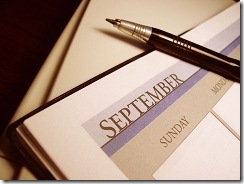James over at Organize IT is talking about a new way he is prioritizing his tasks. He makes some good arguments for ditching the high, medium and low task priorities most of us are used to for a new 3 step priority method.
The traditional approach of prioritizing, where you assign a task a high, medium or low priority (or maybe even something more meaningless than that) is outdated and largely ineffectual in today’s workplace. In fact David Allen of Getting Things Done fame actively downplays the importance of prioritizing, claiming that each task is equally important otherwise you wouldn’t be doing them in the first place. However, this implies a “need to do-don’t need to do” attitude which, as I’ve discussed before, can be a surefire way to end up burnt out as you continuously feel compelled to do something.
He has his 3 priorities laid out thusly:
- Need to do
- Should do
- Want to do
Of course the highest priority in this chain is Need to do. These are things like putting gas in your car, turning in work on schedule and subscribing to my RSS feed ![]() . These are the tasks that if you don’t do them, you’ll be punished either directly or by the universe. Not putting gas in your car punishes you by you breaking down at the side of the road and having to walk 3 miles to a gas station. Not turning in your work in time results in getting in trouble at work. I don’t even want to get into the horrors you’ll experience if you haven’t subscribed to my updates yet.
. These are the tasks that if you don’t do them, you’ll be punished either directly or by the universe. Not putting gas in your car punishes you by you breaking down at the side of the road and having to walk 3 miles to a gas station. Not turning in your work in time results in getting in trouble at work. I don’t even want to get into the horrors you’ll experience if you haven’t subscribed to my updates yet. ![]()
His next is Should do’s. It’s my understanding the should do’s are things like writing thank you notes and turning in your work early. There’s no consequences for not doing a should do – at least for now. But you’ve committed to doing it so you might as well do it.
Finally there is the category Want to do. Probably all of these tasks will get done because you want to do them. They are things like going out to eat or watching a movie.
As I use the old style ABC 123 priorities on my daily task list, I am not sure how well I’d adjust to this method. It seems to me there would be some confusion in not knowing what comes first, second and third.
Example:
- A1 Put Money in bank
- A2 Write checks for bills
- A3 Mail bills
In an ABC 123 prioritized list you know the first step, second and so on…
Where if you had one category Need to do and put the same tasks in there, depending on the order, you might have something that looks like this:
Need to do:
- Mail bills
- Write checks
- Put money into bank
Where do you start? Logic dictates you’ll figure it out of course. But I like the first method because you have a start and an end.
That’s not to say James’ method isn’t sound. I think he’s onto something. Since many are motivated by pure emotion, perhaps knowing “I need to do this, this and that.” is enough. But I’d like to see more of how to actually work the tasks in the list.
By the way, the first thing I think of when you put things on the Want to do list is that they are probably the least important to do. They likely bring in the least profit, cost the most expense and lost time. So after a week or two of implementing the method, a productivity maniac might consider just throwing out the want to do’s.
What are your thoughts on James’ method? Would you be better motivated by having a 3 category list of Need, should and want to dos? Or do you like another method? Please tell us in the comments.



{ 5 comments }
Brad, I don’t see these classifications as mutually exclusive – I use the ABCDE method – A is the need to/must do, B is the ought to/should do, C is the want/nice to do. D is delegate, and E is eliminate.
The great thing about using the ABCDE system is, as you say, you can subcategorize them into 123, etc, so that you have as detailed a priority list as you could possibly want. Do the A’s first or the boss is going to be breathing down your neck (or worse), and do them in 123 order. If you get to the B’s, great (do in the 123 order). If not, reprioritize for the next day (they will still be there unless you assign them to E).
Also, remember that if you do the ABCDE system first, you will have reduced the task list substantially. You can just call those first three whatever you want. Oh, and if you are lucky enough to have so few tasks that you can’t prioritize them, group them all together as just plain old A’s.
I love your posts simplicity.
Sometimes it is difficult to “clear cut” the boundaries
Shamelles last blog post..6 Things Simon Cowell (Of American Idol) Would Say About Your Blog!
Rod, I’m with you, I see A as being critical must do’s B’s as like to do and C’s as want to do’s. In fact, I learned the ABC method from Franklin covey and they state that the C’s are stuff you want to do. But I’d still like to see how James gets a handle on each task under the categories.
Thanks for mentioning my post! I agree that you can have A = “need to do” and B = “should do” if you prefer. However I like to use the actual words because it really emphasizes what that priority actually means. If someone else looks at the list they understand exactly what it means. They wouldn’t necessarily understand A, B and C.
The benefit of my approach (as I see it) is how to takes time into account. Under a traditional prioritizing scheme, paying a bill would immediately be an high priority. High priority or not, in my system it emphases the fact you don’t have to pay it there and then. Because of that you can control how many high priority tasks you have, spread them out over time and even pre-empt tasks by acting on them when are at the “should do” level (essentially doing the important/not urgent work in the 7 Habits methodology).
There is a lot more I can potentially write about this. I’m going to give it some more thought and do another blog post in the near future. Thanks for your feedback!
Jamess last blog post..Organize IT Recap: Investing, Writing Binding Contracts
Generally, this approach is right, but there is also evolving a new chaotic approach – do what you really like to do… It sounds crazy, but look around you – many people operate using this approach and they are quite successful. There is always some to pick those small tasks you do not want to do /and you should do/.
Lukes last blog post..Interviewing a wrong person
{ 1 trackback }